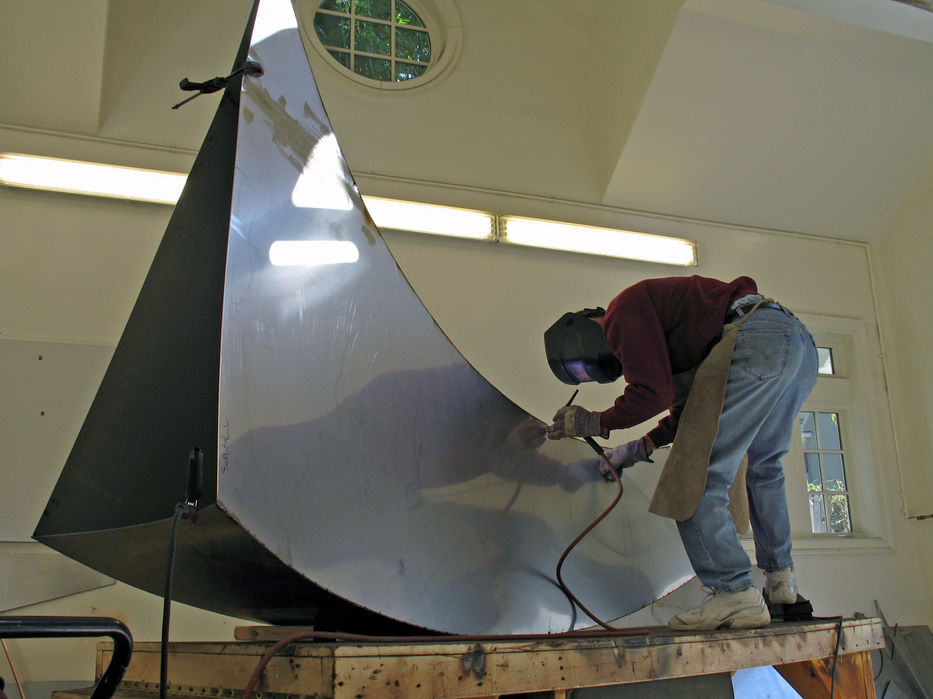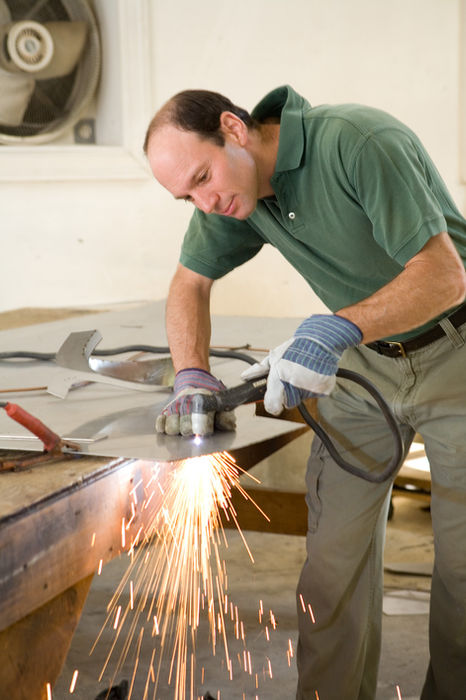

The Process
All sculpture is fabricated at Rubenstein Studios. The fabrication process involves a number of steps. After receiving bronze or stainless steel as sheet material, shapes are cut using various saws and cutters. The shapes are then joined by welding, ensuring a strong and durable connection. Welding, incidentally, is not a mechanical bond. It is the connection of like-metals to form one continuous metal, i.e., chemically contiguous. Grinding is then performed to render the edges smooth and clean. Finally, a finish is created on the surface. For stainless steel, typically a brushed finished is created with a grinding tool, and for bronze, a chemical or patina is applied, which colors the surface and penetrates the metal’s pores. When aluminum is used, the surface is coated with a color, creating a chemical bond.
All of the artwork is created with durable materials that are excellent for indoor and outdoor environments. Bronze, stainless steel, and stone are typically used in outdoor environments. These materials will not rust or corrode. Stainless steel will always keep its shimmering and brilliant finish, while a patinated or colored bronze will change gradually over time, dependent on the climate and air quality of the environment. All sculptures are carefully engineered to withstand high winds (up to 120 mph), severe climates, and can withstand the accumulation of snow/ice as well as the occasional “kids on sculpture” phenomenon.
In indoor environments, the above materials are extremely stable.
Water sculpture is designed for both indoor and outdoor environments. Water sculptures can be designed to incorporate a reservoir, also acting as its base, allowing for easy installation and portability. Using water-heating systems, outdoor water sculptures are able to continuously run through most winters. During the winter, ice will naturally accumulate on and around the sculpture, creating a dramatic effect. The pipes however will remain unfrozen and the sculpture will not be at risk.
Kinetic sculpture uses high-tech plastic and glass bearings that have no maintenance and last for many years.All artwork is secured with concrete foundations. With water sculpture, installation can use one of the following two site designs:
1) Pool: Placing a sculpture in a pool adds a dramatic quality to a site. Both the sound and visual presentations are different, with underwater lights creating a shimmering effect at night.
2) Stony Field / Reservoir System: This involves placing a reservoir in the ground, and then setting a rubber tarp around it. Stones are then placed over the entire system, so that the sculpture appears to rise out of the stone.
Both designs allow for the recycling of the water. However, with the natural evaporation of water, it is typical to install an automatic tip-off valve, so that the water level remains constant. The installation also requires access to electrical and water sources. With electric timers, the operation of a water sculpture (and its lights) is controlled automatically. Water heaters also run automatically, activated by cold temperatures. Maintenance of the pool or stony field / reservoir system involves a similar schedule of algaecide as a swimming pool would need, but much less, because these sculptures are constantly recirculating the water.Both safety and maintenance requirements have been carefully considered so as to minimize health hazards and maintenance requirements.
Rubenstein recommends washing the artwork at least once a year. This can be done with a hose, non-abrasive soap, and a soft towel (much like a car). Stainless steel sculptures require no wax. Occasionally, bird droppings or atmospheric dust can cause a small mark on the surface, which can be removed with the use of “Bar Keeper’s Friend,” a common product used to clean stainless steel. Pour the powder onto a damp cloth, and carefully rub it in circles on the artwork to remove the mark. Then, hose the area thoroughly, as this product has some acid in its ingredients.
More details can be provided upon request.

























